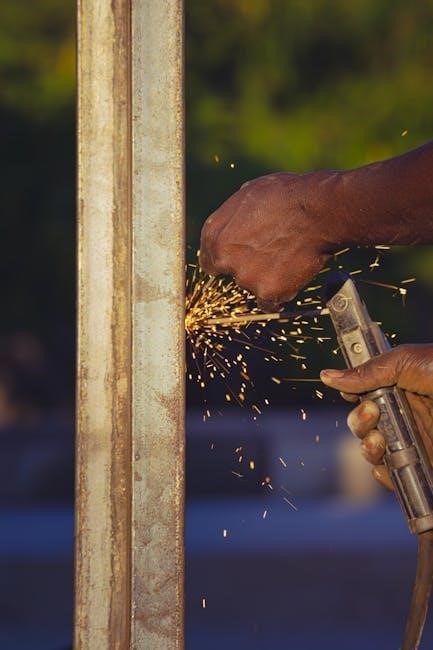A WPS, or Welding Procedure Specification, is a detailed guide outlining the parameters and requirements for welding operations to ensure quality and safety standards are met consistently.
1.1 What is a WPS?
A Welding Procedure Specification (WPS) is a written document that outlines the specific parameters and requirements for welding operations. It serves as a detailed guide, ensuring that welds are produced consistently and meet established quality and safety standards. The WPS typically includes information about the materials being welded, the welding process, filler metals, shielding gases, and the exact parameters such as voltage, current, and travel speed. It also addresses pre-weld and post-weld treatments, inspection criteria, and any special requirements. By standardizing the welding process, a WPS helps ensure reliability, repeatability, and compliance with industry codes and standards. It is an essential tool for achieving high-quality welds and minimizing defects or errors during fabrication.
1.2 Importance of WPS in Welding
The Welding Procedure Specification (WPS) plays a critical role in ensuring the quality, safety, and consistency of welding operations. By providing standardized instructions, it minimizes variability and reduces the risk of defects, which can lead to costly rework or even safety hazards. A WPS ensures compliance with industry standards and regulatory requirements, enhancing the credibility of the welding process. It also serves as a communication tool, aligning expectations among welders, inspectors, and clients. Additionally, a well-documented WPS supports training and quality control, fostering a culture of precision and accountability. Ultimately, the WPS is indispensable for maintaining the integrity and reliability of welded products across various industries.

Key Components of a WPS Document
A WPS document includes essential parameters such as materials, welding techniques, filler metals, shielding gases, and heat control, ensuring clarity and consistency in welding operations.
2.1 Essential Variables in WPS
In a WPS, essential variables are critical parameters that directly impact weld quality and integrity. These include the welding process, joint design, base metal types, filler metal specifications, shielding gas composition, current type and polarity, voltage, travel speed, and preheat/postheat treatments. Proper control of these variables ensures compliance with design and safety standards. They are non-negotiable and must be strictly adhered to during welding operations. Any deviation from these parameters could lead to defective welds, compromising the structural integrity of the final product. Therefore, identifying and maintaining essential variables is crucial for producing consistent, high-quality welds in various industries.
2.2 Non-Essential Variables and Their Role
Non-essential variables in a WPS are parameters that do not directly affect the mechanical properties or quality of the weld but can influence the welding process’s efficiency and consistency. These variables may include the type of electrode holder, welding torch nozzle, or the specific brand of shielding gas. While they are not critical to the weld’s integrity, they can impact the welder’s performance, equipment setup, and operational ergonomics. Non-essential variables are often specified to standardize practices, reduce variability, and ensure repeatability across different welders or shifts. They play a supporting role in maintaining consistency and optimizing the welding process without being critical to the weld’s structural integrity.

Development of a WPS
Developing a WPS involves a systematic process to define welding parameters, ensuring compliance with standards and specifications to achieve desired weld quality and performance.
3.1 Steps to Create a WPS
Creating a WPS involves a structured approach to ensure clarity and compliance. Begin by defining the scope and objective, identifying the materials, processes, and equipment to be used. Next, specify the essential variables, such as welding technique, joint design, and shielding gas. Develop detailed procedure qualification requirements, including pre-weld and post-weld inspections. Document all parameters, including filler metals, heat input, and welding positions. Conduct testing to validate the procedure, and record the results. Finally, obtain approval from authorized personnel and maintain detailed records for traceability; Regular reviews and updates ensure the WPS remains effective and aligned with industry standards.
3.2 Approval and Certification Process
The approval and certification process ensures the WPS meets industry standards and regulatory requirements. Once the WPS is drafted, it is submitted to authorized personnel for review and approval. The document is verified for completeness, accuracy, and compliance with relevant codes and specifications. Testing may be required to validate the procedure, and results are documented. Upon approval, the WPS is certified, and a record of certification is maintained. In some cases, third-party certification bodies may be involved to validate compliance. Regular reviews and updates are necessary to maintain certification, ensuring the WPS remains effective and aligned with current standards. Proper documentation and traceability are critical throughout the process.

Implementation of WPS in Welding Operations
Implementation involves training welding personnel, ensuring proper equipment setup, supervision, monitoring adherence, and continuous improvement to maintain quality and safety in welding operations.
4.1 Role of WPS in Quality Control
The WPS plays a crucial role in quality control by providing standardized welding procedures that ensure consistency and compliance with industry standards. It outlines specific parameters, such as materials, techniques, and acceptable tolerances, which guide welders to produce high-quality results. By adhering to the WPS, welding operations minimize variability and reduce the risk of defects. Quality control teams use the WPS as a reference to inspect and verify welds, ensuring they meet specified criteria. Additionally, the WPS often includes requirements for documentation, testing, and inspection, further enhancing traceability and accountability. This systematic approach ensures that final products meet safety, durability, and performance expectations, making the WPS indispensable in maintaining quality across welding operations.
4.2 Training and Awareness for Welding Personnel
Training and awareness for welding personnel are essential to ensure effective implementation of the WPS. Welders, inspectors, and supervisors must understand the WPS document in detail to comply with its requirements. Proper training ensures that all team members can interpret and apply the specified parameters, techniques, and safety guidelines correctly. This includes understanding essential variables, joint designs, welding techniques, and documentation processes. Regular workshops, seminars, and hands-on sessions are recommended to maintain proficiency. Additionally, refresher courses help personnel stay updated on new technologies and standards. By fostering a culture of continuous learning, organizations can enhance welding quality, reduce errors, and promote workplace safety, ensuring adherence to the WPS and industry best practices.


Best Practices for Using WPS
Adhering to WPS ensures compliance with industry standards, enhances weld quality, and improves workplace safety by providing clear guidelines for welding operations consistently and maintaining quality.
5.1 Regular Updates and Revisions

Regular updates and revisions of the WPS are crucial to maintain its relevance and effectiveness in evolving welding operations. As industry standards, materials, and technologies advance, the WPS must be reviewed and modified to reflect these changes. This ensures that welders adhere to the latest best practices and safety protocols. A designated team or committee should be responsible for periodically reviewing the WPS, incorporating feedback from welding personnel, and implementing necessary updates. Proper documentation of revisions is essential for traceability and compliance with quality control measures. Regular updates also help identify obsolete practices and prevent deviations from established guidelines, ensuring consistent weld quality and safety across all projects.
5.2 Compliance with Industry Standards
Compliance with industry standards is a cornerstone of effective WPS implementation. Welding procedures must align with recognized codes and specifications, such as AWS (American Welding Society) and ISO (International Organization for Standardization) standards. Adherence to these guidelines ensures consistency, reliability, and safety in welding operations. By following established standards, organizations can minimize deviations, reduce defects, and maintain high-quality welds. Regular audits and reviews of the WPS against industry benchmarks help verify compliance and identify areas for improvement. Compliance also facilitates certification and acceptance of welds in regulated industries, such as aerospace, construction, and automotive. Ultimately, adhering to industry standards ensures that the WPS meets both technical and regulatory requirements, safeguarding the integrity of welding work.

Leave a Reply
You must be logged in to post a comment.